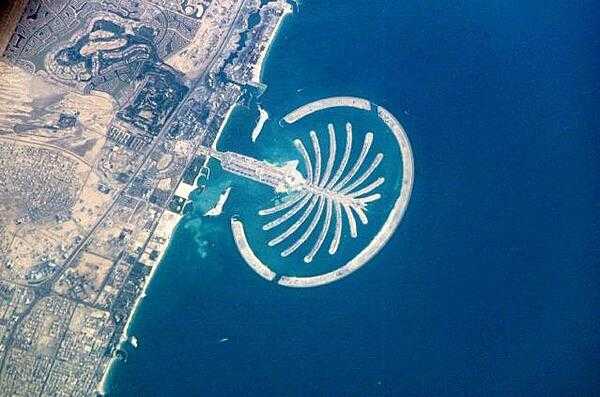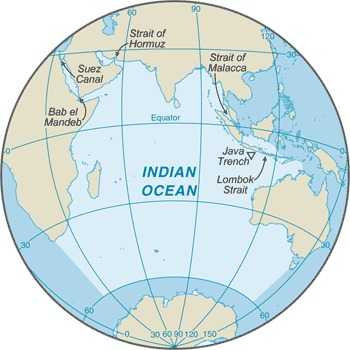Introduction
Background
The Indian Ocean is the third largest of the world's five ocean basins (after the Pacific Ocean and Atlantic Ocean, but larger than the Southern Ocean and Arctic Ocean). Four critically important access waterways are the Suez Canal (Egypt), Bab el Mandeb (Djibouti-Yemen), Strait of Hormuz (Iran-Oman), and Strait of Malacca (Indonesia-Malaysia). The International Hydrographic Organization decided in 2000 to delimit a fifth world ocean basin, the Southern Ocean, which removed the portion of the Indian Ocean south of 60 degrees south latitude.
Visit the Definitions and Notes page to view a description of each topic.
Geography
Location
body of water between Africa, the Southern Ocean, Asia, and Australia
Geographic coordinates
20 00 S, 80 00 E
Area
total : 70.56 million sq km
note: includes Andaman Sea, Arabian Sea, Bay of Bengal, Great Australian Bight, Gulf of Aden, Gulf of Oman, Mozambique Channel, Persian Gulf, Red Sea, Savu Sea, Strait of Malacca, Timor Sea, and other tributary water bodies
Area - comparative
almost 7 times the size of the US
Coastline
66,526 km
Climate
northeast monsoon (December to April), southwest monsoon (June to October); tropical cyclones occur during May/June and October/November in the northern Indian Ocean and January/February in the southern Indian Ocean
Ocean volume
ocean volume: 264 million cu km
percent of World Ocean total volume: 19.8%
Major ocean currents
the counterclockwise Indian Ocean Gyre comprised of the southward flowing warm Agulhas and East Madagascar Currents in the west, the eastward flowing South Indian Current in the south, the northward flowing cold West Australian Current in the east, and the westward flowing South Equatorial Current in the north; a distinctive annual reversal of surface currents occurs in the northern Indian Ocean; low atmospheric pressure over southwest Asia from hot, rising, summer air results in the southwest monsoon and southwest-to-northeast winds and clockwise currents, while high pressure over northern Asia from cold, falling, winter air results in the northeast monsoon and northeast-to-southwest winds and counterclockwise currents
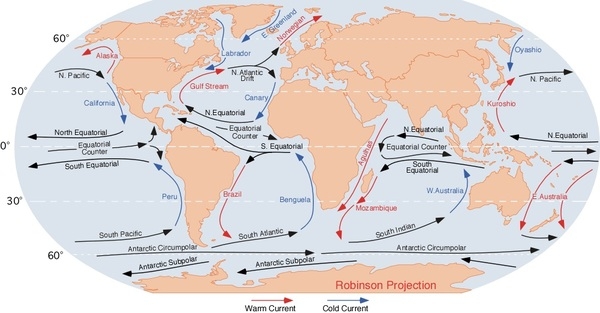
Bathymetry
continental shelf:
The continental shelf (see Figure 1) is a rather flat area of the sea floor adjacent to the coast that gradually slopes from the shore to water depths of about 200 m (660 ft). Dimensions can vary: the shelves may be narrow or nearly nonexistent in some places or extend for hundreds of miles in others. The waters along the continental shelf are usually productive in both plant and animal life, from sunlight and nutrients from ocean upwelling and terrestrial runoff. The following are examples of features found on the continental shelf of the Indian Ocean (see Figure 2):
Exmouth Plateau
Indus Canyon
The Swatch of No Ground/Ganges Canyon (Bay of Bengal)
Sunda Shelf
continental slope:
The continental slope (see Figure 1) is where the ocean bottom drops off more rapidly until it meets the deep-sea floor (abyssal plain) at about 3,200 m (10,500 ft) water depth. The deep waters of the continental slope are characterized by cold temperatures, low light conditions, and very high pressures. Sunlight does not penetrate to these depths, having been absorbed or reflected in the water above. The continental slope can be indented by submarine canyons, often associated with the outflow of major rivers. Another feature of the continental slope is alluvial fans, or cones of sediments, that major rivers carry downstream to the ocean and deposit down the slope. The following are examples of features found on the continental slope of the Indian Ocean (see Figure 2):
Bengal Fan
Indus Fan
abyssal plains:
The abyssal plains (see Figure 1), at depths of over 3,000 m (10,000 ft) and covering 70% of the ocean floor, are the largest habitat on earth. Sunlight does not penetrate to the sea floor, making these deep, dark ecosystems less productive than those along the continental shelf. Despite their name, these “plains” are not uniformly flat; they are interrupted by features like hills, valleys, and seamounts. The following are examples of features found on the abyssal plains of the Indian Ocean (see Figure 2):
Arabian Basin
Crozet Basin
Madagascar Basin
Mid-Indian Basin
Mozambique Basin
Wharton Basin
mid-ocean ridge:
The mid-ocean ridge (see Figure 1), rising up from the abyssal plain, is an underwater mountain range over 64,000 km (40,000 mi) long, reaching an average depth of 2,400 m (8,000 ft). Mid-ocean ridges form at divergent plate boundaries where two tectonic plates are moving apart and magma pushing up from the mantle creates new crust. Tracing their way around the global ocean, this system of underwater volcanoes forms the longest mountain range on Earth. Fracture zones are linear transform faults that develop perpendicular to the line of the mid-ocean ridge, which can offset the ridge line and divide it into segments. The following are examples of mid-ocean ridges found on the floor of the Indian Ocean (see Figure 2):
Central Indian Ridge
Davie Ridge
Southeast Indian Ridge
Southwest Indian Ridge
undersea terrain features:
The Abyssal Plain is commonly interrupted by a variety of undersea terrain features including seamounts, guyots, ridges, and plateaus.
Seamounts (see Figure 1) are submarine mountains at least 1,000 m (3,300 ft) high formed from individual volcanoes on the ocean floor. They are distinct from the plate-boundary volcanic system of the mid-ocean ridges, because seamounts tend to be circular or conical. A circular collapse caldera is often centered at the summit, evidence of a magma chamber within the volcano. "Hot spots" in the deep mantle often feed long chains of seamounts. These hot spots are associated with stationary plumes of molten rock rising from deep within the Earth's mantle. The hot-spot plumes melt through the overlying tectonic plate as it moves and supplies magma to the active volcanic island at the end of the chain of volcanic islands and seamounts.
Flat-topped seamounts are known as guyots.
An undersea ridge is an elongated elevation of varying complexity and size, generally having steep sides.
An undersea plateau is a large, relatively flat elevation that is higher than the surrounding relief with one or more relatively steep sides. Although submerged, these features can reach close to sea level.
The following are examples of undersea terrain features found on the floor of the Indian Ocean (see Figure 2):
Andaman-Nicobar Ridge
Chagos-Laccadive Ridge
Kerguelen Plateau
Madagascar Plateau
Mascarene Plateau
Mozambique Plateau
Ninetyeast Ridge
ocean trenches:
Ocean trenches (see Figure 1) are the deepest parts of the ocean floor and are created by the process of subduction. Trenches form along convergent boundaries where tectonic plates are moving toward each other, and one plate sinks (is subducted) under another. The location where the sinking of a plate occurs is called a subduction zone. Subduction can occur when oceanic crust collides with and sinks under (subducts) continental crust, resulting in volcanic, seismic, and mountain-building processes. Subduction can also occur in the convergence of two oceanic plates, where one will sink under the other and in the process create a deep ocean trench.
Subduction processes in oceanic-to-oceanic plate convergence also result in the formation of volcanoes. Over millions of years, the erupted lava and volcanic debris pile up on the ocean floor until a submarine volcano rises above sea level to form a volcanic island. Such volcanoes are typically strung out in curved chains called island arcs.
The following are examples of ocean trenches found on the floor of the Indian Ocean (see Figure 2):
Java/Sunda Trench; note - deepest point in the Indian Ocean
atolls:
Atolls (see Figure 1) are the remains of dormant volcanic islands. In warm tropical oceans, coral colonies establish themselves on the margins of the island. Then, over time, the high elevation of the island collapses and erodes away to sea level leaving behind an outline of the island in the form of the fringing coral reef. The resulting low island is typified by the coral reef that surrounds a low elevation of sand and coral above sea level, with an interior shallow lagoon. Often the remaining dry land is broken into a ring of islets, and some lagoons can be hundreds of square kilometers.
Guyots are submerged atoll structures, which explains why they are flat-topped seamounts.
The following are examples of atolls found in the Indian Ocean (see Figure 2):
Bassas da India
Chagos Archipelago/Diego Garcia
Europa Island
Juan de Nova Island
Lakshadweep Islands
Maldive Islands
Seychelles
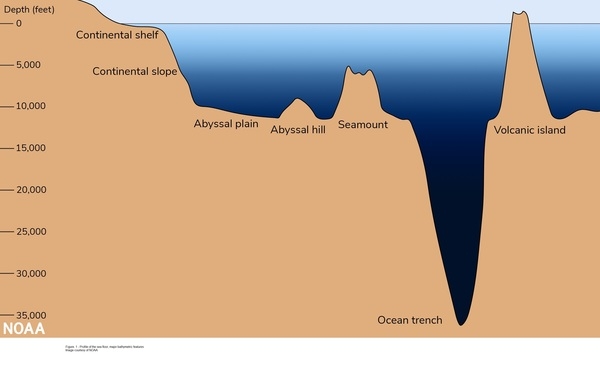
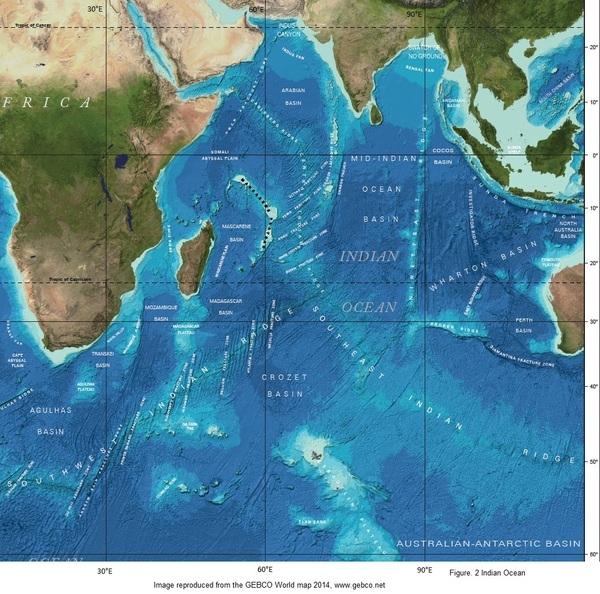
Elevation
highest point: sea level
lowest point: Java Trench -7,192 m unnamed deep
mean depth: -3,741 m
ocean zones: Composed of water and in a fluid state, the oceans are delimited differently than the solid continents. They are divided into three zones based on depth and light level. Sunlight entering the water may travel about 1,000 m into the oceans under the right conditions, but there is rarely any significant light beyond 200 m.
The upper 200 m (656 ft) of oceans is called the euphotic, or "sunlight," zone. This zone contains the vast majority of commercial fisheries and is home to many protected marine mammals and sea turtles. Only a small amount of light penetrates beyond this depth.
The zone between 200 m (656 ft) and 1,000 m (3,280 ft) is usually referred to as the "twilight" zone, but is officially the dysphotic zone. In this zone, the intensity of light rapidly dissipates as depth increases. Such a minuscule amount of light penetrates beyond a depth of 200 m that photosynthesis is no longer possible.
The aphotic, or "midnight," zone exists in depths below 1,000 m (3,280 ft). Sunlight does not penetrate to these depths, and the zone is bathed in darkness.
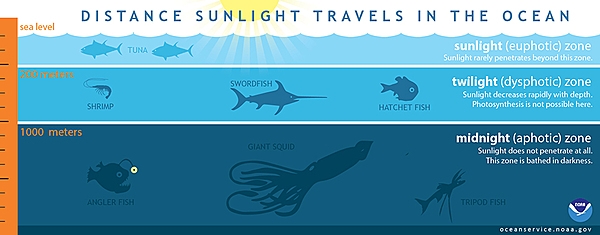
Natural resources
oil and gas fields, fish, shrimp, sand and gravel aggregates, placer deposits, polymetallic nodules
Natural hazards
occasional icebergs pose navigational hazard in southern reaches
Geography - note
major chokepoints include Bab el Mandeb, Strait of Hormuz, Strait of Malacca, southern access to the Suez Canal, and the Lombok Strait
Environment
Environment - current issues
marine pollution caused by ocean dumping, improper waste disposal, and oil spills; deep sea mining; oil pollution in Arabian Sea, Persian Gulf, and Red Sea; coral reefs threatened due to climate change, direct human pressures, and inadequate governance, awareness, and political will; loss of biodiversity; endangered marine species include the dugong, seals, turtles, and whales
Climate
northeast monsoon (December to April), southwest monsoon (June to October); tropical cyclones occur during May/June and October/November in the northern Indian Ocean and January/February in the southern Indian Ocean
Marine fisheries
the Indian Ocean fisheries are the third most important in the world, accounting for 15.5%, or 12,220,000 mt of the global catch in 2020; tuna, small pelagic fish, and shrimp are important species in these regions; the Food and Agriculture Organization delineated two fishing regions in the Indian Ocean:
Eastern Indian Ocean region (Region 57) is the most important and the fifth-largest-producing region in the world with 8.4%, or 6,590,000 mt, of the global catch in 2020; the region encompasses the waters north of 55º South latitude and east of 80º East longitude, including the Bay of Bengal and Andaman Sea, with the major producers including India (2,362,481 mt), Indonesia (1,940,558 mt), Burma (1,114,777 mt), Bangladesh (877,837 mt), and Sri Lanka (373,369 mt); the principal catches include shad, skipjack tuna, mackerel, shrimp, and sardinellas
Western Indian Ocean region (Region 51) is the world’s sixth-largest-producing region with more than 7.1% or 5,630,000 mt of the global catch in 2020; this region encompasses the waters north of 40º South latitude and west of 80º East longitude, including the western Indian Ocean, Arabian Sea, Persian Gulf, and Red Sea, as well as the waters along the east coast of Africa and Madagascar, the south coast of the Arabian Peninsula, and the west coast of India; major producers include India (2,207,125 mt), Oman (580,048 mt), Pakistan (341,730 mt), and Mozambique (274,791 mt); the principal catches include skipjack and yellowfin tuna, mackerel, sardines, shrimp, and cephalopodsRegional fisheries bodies: Indian Ocean Tuna Commission, Commission for the Conservation of Southern Bluefin Tuna, Regional Commission for Fisheries (Persian Gulf/Gulf of Oman), Southeast Asia Fisheries Development Center, Southwest Indian Ocean Fisheries Commission, South Indian Ocean Fisheries Agreement
Government
Country name
etymology: named for the country of India, which makes up much of its northern border
